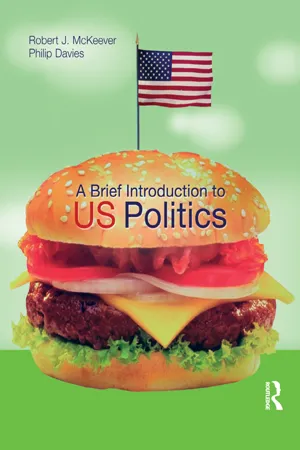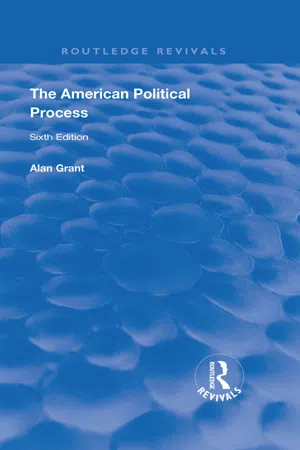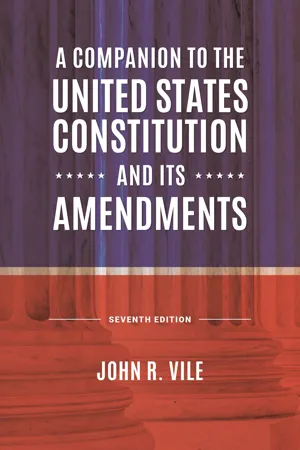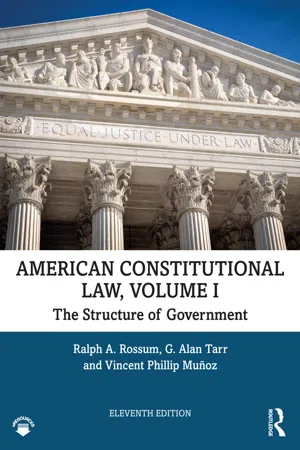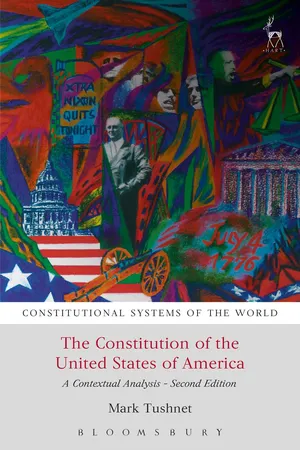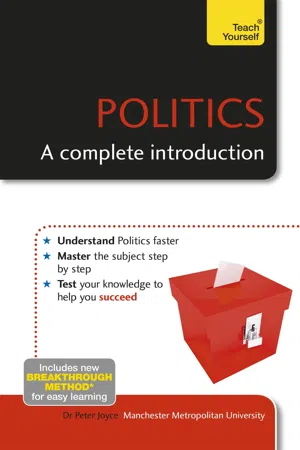Law
Legislative Power US
Legislative power in the US refers to the authority vested in the legislative branch of the government to create, amend, and repeal laws. This power is primarily held by the Congress, which is composed of the Senate and the House of Representatives. Through the legislative process, these bodies have the ability to propose, debate, and ultimately enact legislation that shapes the legal framework of the country.
Written by Perlego with AI-assistance
Related key terms
Related key terms
1 of 4
Related key terms
1 of 3
9 Key excerpts on "Legislative Power US"
- eBook - ePub
- Robert J. Mckeever(Author)
- 2014(Publication Date)
- Routledge(Publisher)
Chapter 7 The CongressCongress and the president are rivals for political power generally, and legislative power in particular. To a considerable extent, this rivalry is a ‘zero-sum’ game: any increase in the power of one player inevitably means a corresponding loss of power for the other. Nevertheless, as a responsible national legislature, Congress cannot simply devote itself to institutional self-preservation. It must pass laws to advance the national interest and, to do this, it needs to cooperate with the president. In this chapter, we trace the origins and development of this ambiguous relationship with the presidency and assess the contemporary balance of power between the two. We also examine the main structures, processes and procedures that determine the way that Congress works, in order to understand both the strengths and weaknesses of the national legislature.Legislative power: the constitutional designLegislative power is the power to pass laws. It lies, therefore, at the heart of the policymaking process and, indeed, is a central attribute of what we more generally call political power. Although the framers of the Constitution were concerned that no single institution should accrue too much political power, it is clear that they entrusted legislative power mainly to the Congress. True, the president was also given a role in the legislative process, but it was not until the twentieth century that he began to expand this role at the expense of Congress and to assume legislative leadership.Legislative powers of CongressArticle I of the Constitution begins by stating that ‘All legislative powers herein granted shall be vested in a Congress of the United States, which shall consist of a Senate and House of Representatives’. Section 8 of Article I goes on to specify the particular powers which the framers wished to transfer from state legislatures to the federal legislature. Among the most important of these enumerated powers - eBook - ePub
- Alan Grant(Author)
- 2019(Publication Date)
- Routledge(Publisher)
2 Making the Laws: The American CongressThe Role of the Legislature
No other legislative assembly in the world probably fits the description of a ‘law-making body’ better than the United States Congress. In most democratic countries effective initiation of policies and laws has been taken over by the executive branch, and the legislature has generally become a body that reacts to and passes proposals put forward by the government. Nelson Polsby has described such bodies as ‘arena legislatures’ where parliaments become principally the forums for debate and approval of executive-inspired legislation. The US Congress, on the other hand, he calls a ‘transformative legislature’ enjoying an independent capacity, frequently exercised, to mould and transform proposals into law.1 The Congress was given the function of law-making in the Constitution and, because of the separation of powers principle, it has to a large extent retained its powers over the initiation and passage of laws. Even in the United States, the President has played an increasing role in recommending and proposing legislation, but he still has to rely on friendly Congressmen to introduce his bills into Congress, and he is by no means certain of securing their passage. The legislature is seen as being constantly in a checking and balancing relationship with the President; there will always be friction and tension and occasionally direct conflict between the rival policies and interests of each branch. The Congress has, therefore, been called the most powerful legislature in the world; every year sees the introduction of thousands of proposals, but only a small minority ever became law by surviving the obstacle race of the legislative process. In the 102nd Congress, for example, 12,016 bills and resolutions were introduced, many overlapping and on similar topics, but only 590 became public laws in the two-year period.2 - eBook - ePub
American Constitutional Law 8E, 2-VOL SET
2-VOLUME SET
- Ralph A. Rossum(Author)
- 0(Publication Date)
- Routledge(Publisher)
Chadha, this veto is not legally binding. Nevertheless, executive officials typically agree to abide by the veto, lest Congress reduce their flexibility of action by a less-generous delegation of power. Thus, despite the Court's ruling, the legislative veto—and congressional efforts to continue broad delegations of power without losing control over policymaking—are far from dead.CONCLUSIONS
Several conclusions emerge from our review of the constitutional provisions defining Congress's powers and regulating their exercise. First, Congress's constitutional powers are exceedingly broad, in addition to conferring on Congress important enumerated powers, the Constitution, through the Necessary and Proper Clause, provides extensive additional powers that allow Congress necessary flexibility to fulfill its constitutional responsibilities. In addition, the Supreme Court, by foreclosing review through the "political-questions doctrine," has acknowledged Congress's broad discretion in the exercise of such nonlegislative powers as supervising the amendment process and hearing impeachments.Second, the Constitution has provided Congress with important auxiliary powers and privileges that enable it to fulfill its constitutional responsibilities more effectively. Not only does the Constitution expressly confer on members of Congress various immunities that safeguard the independence of the legislative branch, but the Supreme Court also has recognized that the Constitution permits Congress to obtain necessary information for legislation by conducting investigations and punishing witnesses who refuse to supply pertinent information. Yet the Courts interpretation of these auxiliary powers and privileges offers considerable contrast. On the one hand, the justices have attempted to regulate congressional investigations without imposing requirements that would curtail the scope of congressional investigatory authority. On the other hand, in construing the Speech and Debate Clause, they have been much more willing to define the privilege narrowly and to rule against members of Congress. - John R. Vile(Author)
- 2021(Publication Date)
- Praeger(Publisher)
Similarly, the third paragraph limits states from exercising other powers that the Constitution reserves for Congress. The section specifies that Congress must approve attempts by states to keep troops in times of peace, to enter into agreements with foreign governments, or to agree to compacts among themselves. The Constitution does, however, permit states to employ defensive forces when they are invaded and delay is impossible.SUMMARYArticle I of the U.S. Constitution outlines the powers of the legislative branch, which delegates to the Constitutional Convention thought would be the most powerful branch and that which would be closest to the people. The Constitution divides Congress into two houses (bicameralism): a House of Representatives, where states are represented according to population, and the Senate, in which each state is represented equally. Although members of the Senate were once selected by state legislators, members of both houses are now elected by the people. Members of the House serve for two-year terms and members of the Senate for six, with qualifications for the Senate being somewhat more stringent than those for the House. Only the House can originate revenue bills and impeach certain officials, while only the Senate can ratify federal treaties, confirm presidential appointments, and try impeachment trials. To become laws, bills must pass both houses of Congress and either be signed by the president or repassed by both houses by a two-thirds vote or more. The central powers of Congress, the most important of which involve the power of the purse, are enumerated in Article I, Section 8, but this enumeration includes the necessary and proper clause that recognizes the existence of certain implied powers. Article I, Section 9 further lists restraints on Congress, while Article I, Section 10 lists further restraints on the states.- eBook - ePub
Princeton Studies in American Politics
Legislative Capacity and the Dynamics of Executive Power
- Alexander Bolton, Sharece Thrower(Authors)
- 2021(Publication Date)
- Princeton University Press(Publisher)
Both policymaking and resource capacities are necessary conditions for legislatures to be high-capacity institutions in our conceptual framework. Lacking either leaves them illequipped to constrict executive power.Legislative capacity is by no means a fixed or predetermined entity. It has varied substantially in both historical and contemporary eras, across Congress and state legislatures. These changes, which we explain and leverage throughout the book, have produced significant consequences for the distribution of policymaking power in the United States and for the question of whether executive power is constrained in different contexts.Transformations in Legislative Capacity across Time and Context
Writing in 1888, British statesman Lord Bryce observed, “Congress … has succeeded in occupying most of the ground which the Constitution left debatable between the president and itself” (Bryce 1995 [1888], 203). Presidents in the nineteenth century, particularly after the Civil War, are frequently described as forgotten clerks who left little imprint on the institution (Neustadt 1990 [1960]). Given its constitutional powers and the limited functions of the government in the early republic, Congress naturally became the center of US governance and dominated federal policymaking during this era.Yet, by the turn of the twentieth century, Congress found itself outmatched by the growing technological, social, and economic challenges facing the country and an energetic executive branch seemingly better positioned to manage these dramatic developments (Cooper 2017). The federal government undertook unprecedented economic and social interventions that continued through the New Deal and World War II.Presidents responded to this shift in the locus of policymaking power by seizing greater control over executive branch agencies, typically with congressional acquiescence. During the first four decades of the twentieth century, Congress responded little in terms of institutional change to the extraordinary policy developments it was itself creating. As the federal government expanded, Congress stayed the same and consequently became relatively less powerful. Legislative staff sizes barely increased, spending on the institution stagnated, and the public showed little appetite for augmenting congressional resources and power. As shown in figure 1.1 , Congress spent $229 million (in 2009 dollars) on itself and employed 225 committee staffers in 1905.12 - eBook - ePub
American Constitutional Law, Volume I
The Structure of Government
- Ralph Rossum, G. Alan Tarr, Vincent Phillip Munoz(Authors)
- 2019(Publication Date)
- Routledge(Publisher)
Chadha, the legislative veto—and congressional efforts to continue broad delegations of power without losing control over policy making—is far from dead.Conclusions
Several conclusions flow from our review of the constitutional provisions defining Congress’s powers and regulating their exercise. First, Congress’s constitutional powers are very broad. In addition to conferring on Congress important enumerated powers, the Constitution, through the Necessary and Proper Clause, provides extensive additional powers that allow Congress the necessary flexibility to fulfill its constitutional responsibilities. In addition, the Supreme Court, by foreclosing review through the “political-questions doctrine,” has acknowledged Congress’s broad discretion in the exercise of such nonlegislative powers as supervising the amendment process and hearing impeachments.Second, the Constitution has provided Congress with important auxiliary powers and privileges that enable it to fulfill its constitutional responsibilities more effectively. Not only does the Constitution expressly confer on members of Congress various immunities that safeguard the independence of the legislative branch, but the Supreme Court has also recognized that the Constitution permits Congress to obtain necessary information for legislation by conducting investigations and punishing witnesses who refuse to supply pertinent information. Yet the Court’s interpretation of these auxiliary powers and privileges offers considerable contrast. On the one hand, the justices have attempted to regulate congressional investigations without imposing requirements that would curtail the scope of congressional investigatory authority. On the other hand, in construing the Speech and Debate Clause, they have been much more willing to define the privilege narrowly and to rule against members of Congress. - eBook - ePub
The Constitution of the United States of America
A Contextual Analysis
- Mark Tushnet(Author)
- 2015(Publication Date)
- Hart Publishing(Publisher)
55 All of them result from discretionary choices by the House and Senate, not mandatory ones imposed by the Constitution. But the discretion and the way it is exercised is dominated by ordinary politics.CONCLUSION
The written Constitution creates the legislative branch, and sets out a few boundary markers on how Congress operates. Yet, one who reads only the written Constitution will know little about Congress. The efficient constitution gives Congress much more definition. Political parties, unmentioned in the written constitution, are the tools that define Congress.FURTHER READINGChambers, WN and Burnham, WD, American Party Systems: Stages of Political Development (New York, Oxford University Press, 1975) (providing an overview of the development of the party system).Oleszek, WJ, Congressional Procedures and the Policy Process (7th edn Washington, CQ Press, 2007) (an overview of congressional processes).Sinclair, B, Unorthodox Lawmaking: New Legislative Processes in the US Congress (3rd edn Washington, CQ Press, 2007) (describes the contemporary processes of congressional lawmaking).1 The legislature of every state save one (Nebraska) is bicameral.2 In 1992 the Supreme Court rejected Montana’s challenge to the statutory apportionment formula: US Dep’t of Commerce v Montana 503 US 442 (1992).3 The Supreme Court held it unconstitutional for states to impose term limits on their state’s House members: US Term Limits v Thornton 514 US 779 (1995).4 The 1789 Constitution provided that Senators would be elected by state legislatures. The Seventeenth Amendment, adopted in 1913, replaced that with direct popular election.5 On the latter qualification, see ch 5 below.6 - Peter Joyce(Author)
- 2015(Publication Date)
- Teach Yourself(Publisher)
12 The legislative branch of governmentThe functions of legislaturesThe main purpose of legislatures is to make law but they also perform other important activities. In this chapter we will examine the key functions performed by legislatures, consider the problems that contemporary legislatures face in carrying out these duties and the initiatives that have been put forward in an attempt to overcome these problems.
The key role of the legislative branch of government is to approve law which citizens are subsequently required to obey.Key idea (1) LAW MAKINGElected legislatures are viewed as the symbol of representative government: as it is not possible for all citizens to directly share in policy making, we elect persons who perform these duties on our behalf. These representatives convene in the country’s legislature (which is referred to as Congress in America, Parliament in the United Kingdom or the Oireachtas in Ireland). This is thus the institution that links the government and the governed. In addition to this symbolic function, legislatures undertake a number of specific tasks which we consider now.Below we will consider the process of law making in the UK parliament.Legislatures constitute the law-making body within a country’s system of government. Thus making the law (or amending or repealing it) is a key function that they perform. A specific, although important, aspect of this role is approving the budget and granting authority for the collection of taxes.• Law making in the UK ParliamentKey idea (2) Law making is a complex process that typically involves a number of stages through which a legislative proposal (termed ‘bill’ in the UK and USA) must proceed in order to be transformed into a law that is binding on a nation’s citizens.In the UK a difference exists between public and private legislation. The former constitutes the general law of the land, but the latter is limited in jurisdiction (often being promoted by public bodies such as local authorities to extend their powers). A number of stages are involved in translating a proposal into law. The following outline applies to public legislation. We are assuming that this legislation is first introduced into the House of Commons, which is generally (but not exclusively) the case. Money Bills (which raise or spend public money) are required to originate in the House of Commons.- eBook - ePub
The Constitution of Canada
A Contextual Analysis
- Jeremy Webber(Author)
- 2021(Publication Date)
- Hart Publishing(Publisher)
6The Charter, on the other hand, has indeed restricted parliamentary sovereignty, for neither level of government can enact legislation that offends it. Even here, however, the Charter establishes only the outer limits of legislative power. Within those limits, parliamentary sovereignty continues to operate. Even the limits imposed by the Charter are not absolute. They can, in principle, be changed or abolished using the constitutional amending formula (and indeed, as we will see, parts of the Charter can be set aside using the Charter’s ‘notwithstanding clause’). In a sense, then, all legislation remains possible; it is just that changes to the constitution require the especially demanding legislative process of a constitutional amendment.This reveals the one great truth of constitutional law: decision-making is always ultimately vested in human institutions and thus ultimately under human control. The great task of constitutional law is to establish institutions that citizens broadly consider to be legitimate – a task that is not straightforward, given the diversity of ideas regarding legitimacy. Parliamentary sovereignty is founded on the idea that this diversity is best resolved, and the most legitimate arrangements achieved, by vesting ultimate power in the institution that best represents the people. Such an institution should be directly answerable to citizens so that, to the greatest extent possible, the people govern themselves.II. CANADIAN PARLIAMENTSAt both the federal and provincial levels in Canada, legislative power is exercised by Parliaments. Canadian usage tends to attach the term ‘parliament’ to the federal legislature (Parliament of Canada) and to apply ‘legislature’ to the provincial institutions. However, the structure of the law-making branch is essentially the same at both levels (with the notable exception of the Canadian Senate). Indeed, from time to time we will use the collective term ‘legislatures’ to refer to the law-making institutions at both federal and provincial levels.
Index pages curate the most relevant extracts from our library of academic textbooks. They’ve been created using an in-house natural language model (NLM), each adding context and meaning to key research topics.
Explore more topic indexes
Explore more topic indexes
1 of 6
Explore more topic indexes
1 of 4
